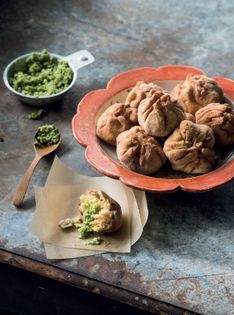Advertisement

Preparation info
- Makes about
30
- Difficulty
Medium
- Ready in
1 hr 25
Appears in
Published 2018
Momos originated in Tibet — but with the movement of the Tibetan people around the world, every country in the mountainous areas of the subcontinent consider momos as their own. This cabbage and buckwheat momo, however, is uniquely Bhutanese. The great thing with these is that you can fry or steam them.
Ingredients
- Chutney for momos, to serve
Method
To make the filling, put the cabbage in a covered steamer basket over a wok or saucepan of simmering water for 5 minutes. Drain well, leave to cool, then squeeze dry. Finely chop the cabbage, place in a large bowl and set aside.
Using a spice or coffee grinder, pulverise the poppy seeds and peppercorns to a fine powder. Add to the cabbage, along with the onion, garlic, ginger, feta, chi


